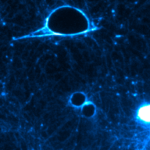Lien vers Pubmed [PMID] – 31431523
Proc. Natl. Acad. Sci. U.S.A. 2019 Sep;116(36):18098-18108
Botulinum neurotoxin type B (BoNT/B) recognizes nerve terminals by binding to 2 receptor components: a polysialoganglioside, predominantly GT1b, and synaptotagmin 1/2. It is widely thought that BoNT/B initially binds to GT1b then diffuses in the plane of the membrane to interact with synaptotagmin. We have addressed the hypothesis that a GT1b-synaptotagmin complex forms the BoNT/B receptor. We identified a consensus glycosphingolipid-binding motif in the extracellular juxtamembrane domain of synaptotagmins 1/2 and confirmed by Langmuir monolayer, surface plasmon resonance, and circular dichroism that GT1b interacts with synaptotagmin peptides containing this sequence, inducing α-helical structure. Molecular modeling and tryptophan fluorescence spectroscopy were consistent with the intertwining of GT1b and synaptotagmin, involving interactions between the oligosaccharide and ceramide moieties of GT1b and the juxtamembrane and transmembrane domains of synaptotagmin, respectively. Furthermore, a point mutation on synaptotagmin, located outside of the BoNT/B-binding segment, inhibited GT1b binding and blocked GT1b-induced potentiation of BoNT/B binding to synaptotagmin-expressing cells. Our findings are consistent with a model in which a preassembled GT1b-synaptotagmin complex constitutes the high-affinity BoNT/B receptor.
